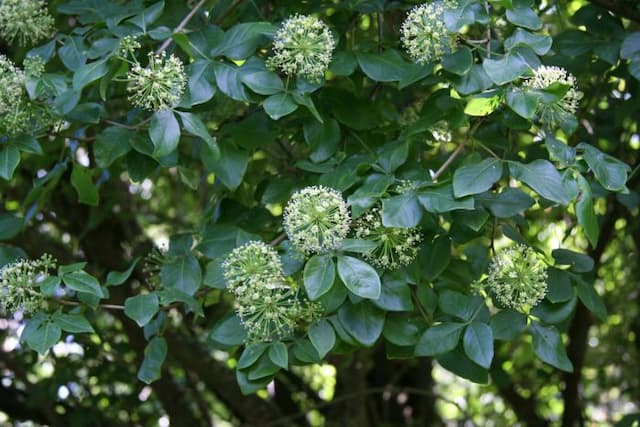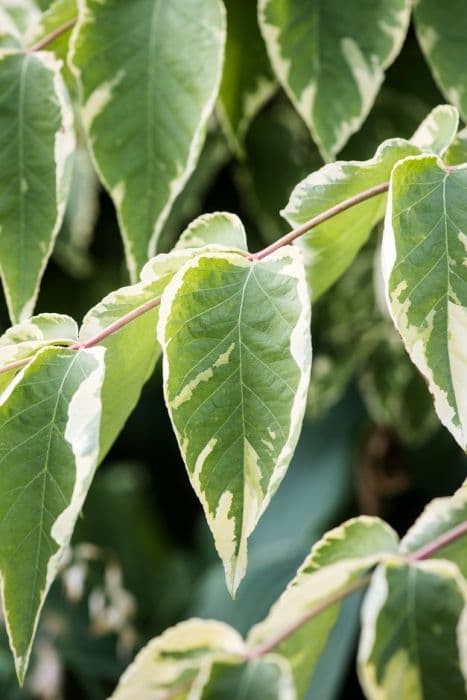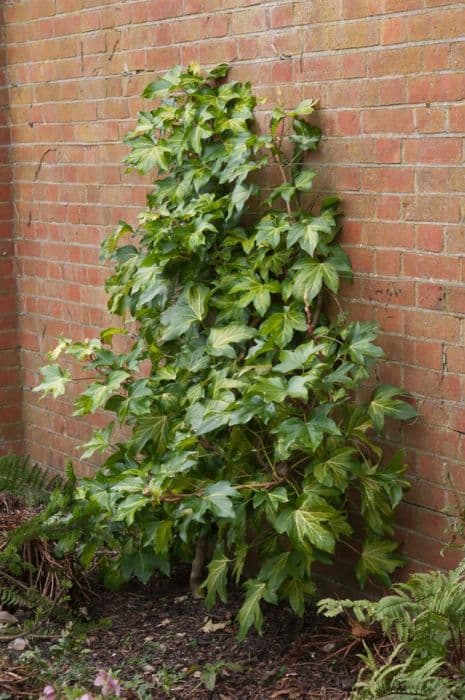Devil's Club Oplopanax horridus






ABOUT
Commonly known as Devil's club, this plant is a standout in its habitat due to its unique appearance. The main stem and large leaf stalks of Devil's club are covered with stout, sharp spines that can easily pierce the skin. The leaves are broad, palmate, and deeply lobed, resembling those of a maple, and they form an umbrella-like canopy. Each leaf is notably large and can be very impressive to look upon. The plant bears small, whitish-green flowers that are clustered together in umbrella-like bunches. These flower clusters give way to vibrant red berries that contrast strikingly with the green of the leaves and the darkness of its wooded environments. The overall appearance of Devil's club is both majestic and formidable, with its spiny defenses deterring animals and unwary hikers alike from close contact.
About this plant
 Names
NamesFamily
Araliaceae.
Synonyms
Devil's Club, Devil's Walking Stick, Alaska Ginseng, Stinktree.
Common names
Fatsia horrida, Panax horridus, Echinopanax horridus, Ricinophyllum horridum.
 Toxicity
ToxicityTo humans
Oplopanax horridus, commonly known as Devil's club, contains various compounds that can be toxic to humans if ingested. The plant has been reported to contain saponins and polyacetylenes, which can cause symptoms such as stomach upset, vomiting, and diarrhea if ingested in significant quantities. It is also important to note that Devil's club has large spines that can cause irritation and injury on contact, although this is physical rather than chemical toxicity. Care should be taken to avoid ingesting any part of the plant or handling it without proper protection to prevent these adverse reactions.
To pets
Devil's club is also toxic to pets, with the risks mirroring those to humans. If pets ingest parts of Oplopanax horridus, they may experience symptoms similar to those in humans, such as gastrointestinal upset, vomiting, and diarrhea. The physical risks posed by the spines are also a concern for pets that might come into contact with the plant. It is important to prevent pets from ingesting or interacting with this plant to avoid these toxic effects.
 Characteristics
CharacteristicsLife cycle
Perennials
Foliage type
Deciduous
Color of leaves
Green
Flower color
White
Height
8 feet (2.4 meters)
Spread
6 feet (1.8 meters)
Plant type
Shrub
Hardiness zones
7
Native area
North America
Benefits
 General Benefits
General Benefits- Wildlife Habitat: Devils club provides a dense habitat that can offer shelter and nesting opportunities for various wildlife species.
- Food Source for Wildlife: Its berries are a food source for birds and other wildlife.
- Erosion Control: The plant has a robust root system that helps stabilize soil and prevent erosion in forested areas.
- Cultural Significance: For indigenous peoples of the Pacific Northwest, Devi's club holds cultural and spiritual importance in their traditions.
- Landscape Aesthetics: Its large leaves and unique appearance can add a natural, unrefined aesthetic to wild gardens and nature preserves.
- Pollinator Support: The plant’s flowers can provide nectar and pollen for local pollinators, contributing to the ecosystem’s health.
 Medical Properties
Medical Properties- Immunomodulatory effects: Oplopanax horridus, commonly known as devil's club, is traditionally believed to have properties that may influence or modulate the immune system.
- Antimicrobial activity: Some research suggests that devil's club may have components that can inhibit the growth of certain bacteria and other microorganisms.
- Anti-inflammatory properties: Devil's club has been used in traditional medicine to potentially reduce inflammation and treat related conditions.
- Respiratory health: It has been used to address respiratory issues, such as coughs and colds, possibly due to expectorant properties.
- Analgesic effects: Devil's club may have been used to alleviate pain, which could be attributed to potential analgesic compounds within the plant.
- Gastrointestinal aid: Traditionally, devil's club has been used to soothe stomach pains and other gastrointestinal complaints.
- Blood sugar regulation: There is some evidence to suggest that devil's club may impact blood sugar levels, although this use is not well-substantiated by clinical research.
 Air-purifying Qualities
Air-purifying QualitiesThis plant is not specifically known for air purifying qualities.
 Other Uses
Other Uses- Oplopanax horridus, commonly known as Devil's Club, has been traditionally used among indigenous people as a protective charm, believed to ward off evil spirits and negative energies.
- Its spiny stems can be used to make fish traps, utilizing the sharp thorns to snag the fish as they swim through.
- The strong, woody stems of Devil's Club have been employed in crafting walking sticks and ceremonial staffs.
- The plant’s large leaves can be used as a natural wrapping material for storing and preserving foods.
- Devil's Club has been used to create natural dyes for textiles, giving fabrics a range of earthy tones.
- Some indigenous cultures have utilized the inner bark to create fibrous material for weaving into baskets and mats.
- The long-lasting, calibration qualities of Devil's Club have been employed in environmental education and wilderness survival training.
- Gardeners may use the dense growth of Devil's Club as a natural barrier to discourage wildlife from entering certain areas.
- In cinematography and theater, Devil's Club has been used to simulate environments in wilderness scenes due to its dense foliage.
- For spiritual and cleansing rituals, some cultures have been known to burn Devil's Club wood as incense or in purification ceremonies.
Interesting Facts
 Feng Shui
Feng ShuiThe Devil's Club is not used in Feng Shui practice.
 Zodiac Sign Compitability
Zodiac Sign CompitabilityThe Devil's Club is not used in astrology practice.
 Plant Symbolism
Plant Symbolism- Resilience: Oplopanax horridus, commonly known as Devil's Club, symbolizes resilience for its ability to thrive in dense forest understories and challenging environments.
- Protection: The plant's formidable spines have led to its association with protection, as it creates a natural barrier in the wild.
- Healing: Traditionally used by indigenous peoples for medicinal purposes, Devil's Club represents healing and the power of nature to restore health.
 Water
WaterDevil's club should be watered when the top inch of soil feels dry to the touch; this can vary from a few days to a week depending on environmental conditions. It's important that the soil is well-draining and the plant is not left in standing water. Typically, watering once every week with 1 to 2 gallons of water should be sufficient. During the growing season, you may need to increase the frequency, whereas in the winter, watering should be reduced to prevent root rot.
 Light
LightDevil's club prefers to grow in partial to full shade, mimicking its native understory habitat. The best spot for the plant is an area that receives filtered light or morning sun with afternoon shade. Direct sunlight can be too intense and cause leaf scorch, so avoid placing it in south-facing locations where the sun is strongest.
 Temperature
TemperatureDevil's club thrives in temperatures between 50°F and 75°F and can withstand short periods of colder or warmer weather. However, the plant is hardy and can survive in temperatures as low as 20°F and as high as 90°F. The ideal temperature range ensures optimal growth and health.
 Pruning
PruningPruning devil's club is usually done to remove dead or damaged stems and to maintain plant health. It's best to prune in late winter or early spring, before new growth begins. Pruning can be done annually, but be cautious of the plant's spines when handling, and always wear protective gloves and clothing.
 Cleaning
CleaningAs needed
 Soil
SoilDevil's club prefers acidic to neutral soil with a pH of 5.0 to 7.0. The best soil mix for this plant would mimic its natural forest floor habitat, consisting of a well-draining mix with plenty of organic matter such as peat moss, compost, and a smaller portion of sand or perlite to promote aeration.
 Repotting
RepottingDevil's club does not require frequent repotting; it can be repotted every 2-3 years. When repotting, ensure the container size is slightly larger than the previous pot to accommodate root growth.
 Humidity & Misting
Humidity & MistingDevil's club thrives in high humidity conditions similar to its natural rainforest environment. Providing humidity levels of 60% or higher is ideal for its best growth and health.
 Suitable locations
Suitable locationsIndoor
Place devil's club in shaded area with high humidity.
Outdoor
Place in partial shade with moist, well-drained soil.
Hardiness zone
5-9 USDA
 Life cycle
Life cycleDevil's club (Oplopanax horridus) begins its life cycle as a seed, which typically germinates in a moist, shaded woodland environment. The germinated seeds develop into seedlings, which gradually form a deep taproot and a spiny stem. As the plant matures, it grows tall woody stems with large, maple-like leaves and the characteristic spines along its stem and leaf veins. The plant reaches maturity and begins to reproduce after several years, producing small white flowers that develop into dense clusters. These flowers are pollinated by insects, after which the plant produces red berries that contain seeds, thus completing the cycle as birds and other animals eat the berries and disperse the seeds.
 Propogation
PropogationPropogation time
Spring-early summer
The most popular method of propagation for Oplopanax horridus, commonly known as Devil's Club, is by seed. The best time for sowing seeds is in the fall, immediately after the fruit has ripened. The seeds have a double dormancy; they require warm stratification followed by cold stratification to break dormancy. To replicate this process artificially, the seeds can be stored at room temperature for 60-90 days and then stratified in the refrigerator for an additional 90-120 days before sowing. The seeds should be planted in a moist, well-draining soil mixture at a shallow depth. Germination can be slow and irregular, often taking several months, so patience is needed when propagating Devil's Club by seed.









